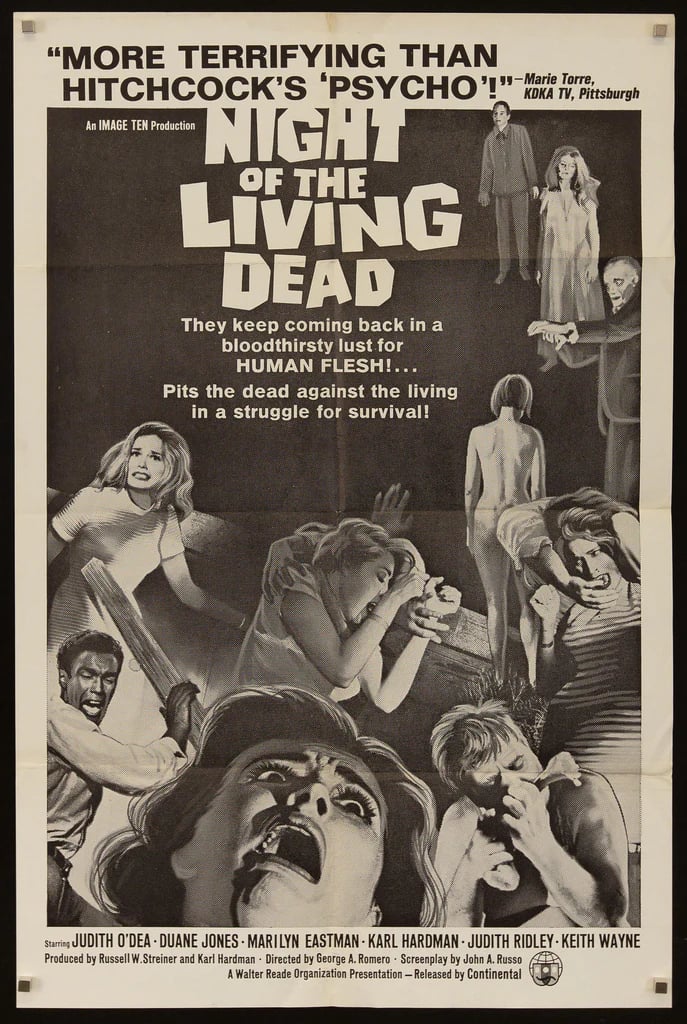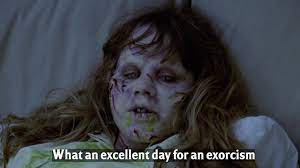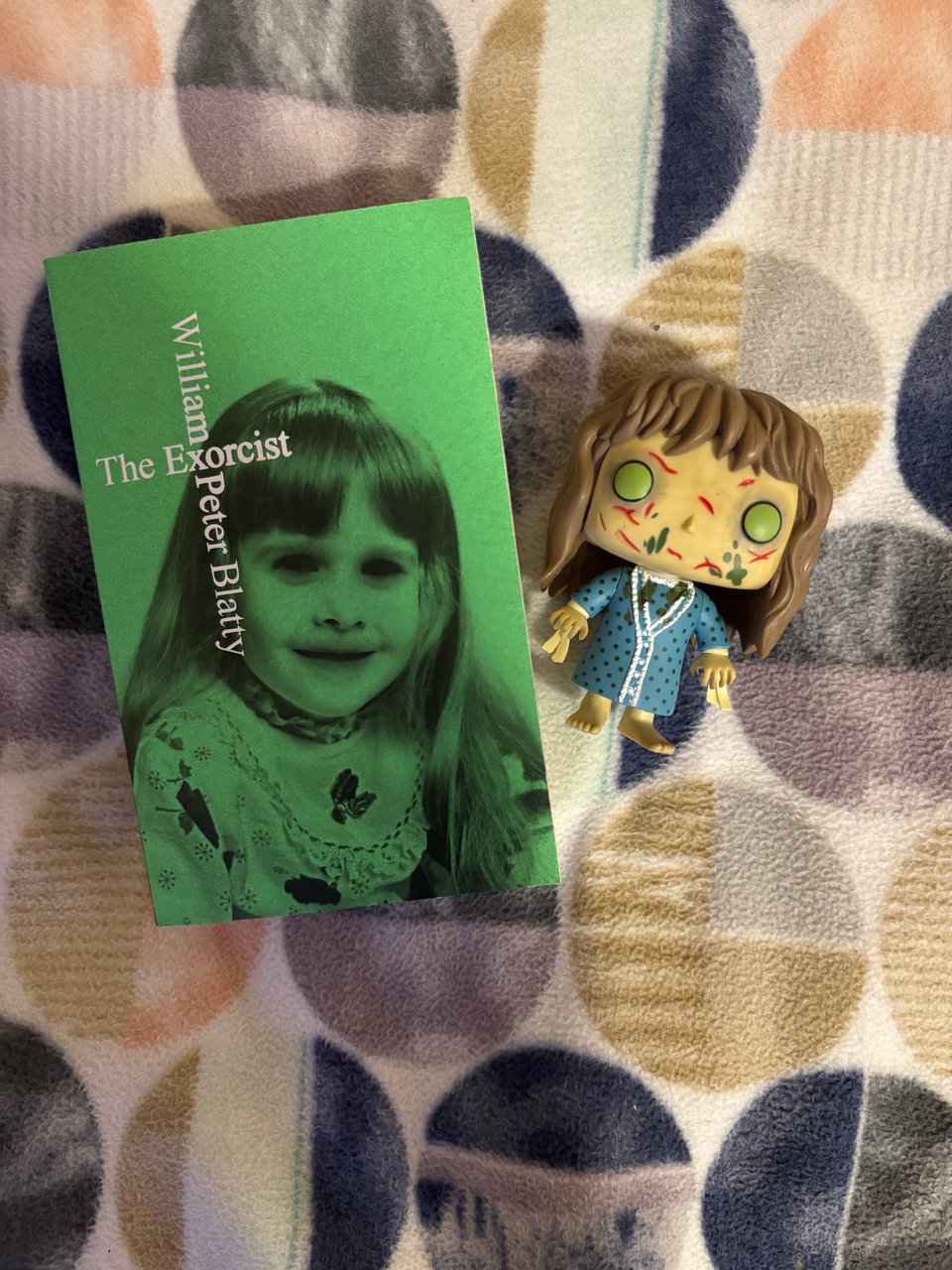Fearmongering: Part Three
A look into the evolution of horror from 1960-1980
Hi all! With Valentine’s Day over, I’m back with more fearmongering! There are (I think) four parts left including this one, if I’ve done my math right, which will take us right up to the one year anniversary of So Desensitized! Unfortunately, that last week of April/first week of May is absolutely insane for me, so the celebration might be a little delayed. I’ll keep you all updated as my schedule becomes clearer. Happy reading, stay spooky, and enjoy the upcoming critical analysis! 🩸
[This post’s charity is, once again, The Marsha P. Johnson Institute, which is fighting the good fight for Black trans civil rights and assistance. Please support in some way if you are able. marshap.org https://www.flipcause.com/secure/cause_pdetails/NjY0OTc ]

As I covered in previous installments of this series, for the first several decades of their existence, horror movies were pretty schlocky. There were some excellent gems in there, like the Universal Monsters, and Godzilla, but for the most part, it wasn’t great. Then, in 1960, Psycho came along and changed everything.
There are a lot of movies that claim to be the first slasher. Black Christmas, The Texas Chain Saw Massacre, and Halloween have all been given that title over the years. None of them, however, are the first slasher. Psycho is. While plenty of movies before it had had huge impacts on cinema at large, and horror specifically, Psycho truly kicked down the door. With an air of secrecy surrounding the film even after its release, a shocking twist halfway through that changed the entire genre of the movie from then on out, and a twist ending that rocked the nation, Psycho was the beginning of horror movies as we know them. And it came at the perfect time, too.
The 1960s were a tumultuous time for America. With the Civil Rights Movement in full swing, America becoming involved in the Vietnam War, the Stonewall Riots at the end of the decade, and the Tate-LaBianca murders just a few months after that, America was in a state of general upset, and would continue to be for a good while. With states of general upset, though, come an awful lot of horror movies.
Following Psycho, horror movies got a lot better, very quickly. The early 1960s gave us masterpieces like The Birds (also Hitchcock), What Ever Happened To Baby Jane?, and The Haunting (an adaptation of Shirley Jackson’s The Haunting Of Hill House). Most early ‘60s horror is still very connected to the war, with hauntings as representations of trauma, fears of invasion, and, slightly newer, fears of aging, of what the war had done to a generation that, while young, seemed quite old. There were a lot of movies about evil kids, too, following in the vein of younger generations being dangerous. The assassination of John F. Kennedy, a staunchly antiwar president, in 1963, also fueled public fears of invasion and incompetent authority figures in America that would later be heightened by America’s involvement in and response to the Vietnam War. Also during this time, Japan had horror movies coming out of the woodwork, most of them creature features or psychological horrors. These are also indicative of post-war fears of the atom bomb, from the country that was ravaged by it. The worst weapon in human history had been unleashed on Japan, traumatizing an entire nation for ever after, and their media has never stopped recognizing it.
Then, right in the middle of this reimagining of horror, America entered the Vietnam War, once again changing the cultural landscape of the entire country. Protests for peace swept the nation, accompanying Civil Rights protests, and, later, LGBTQ+ rights protests. By the late ‘60s and early ‘70s, America was in a state of proper upheaval, and media was, as it always does, reflecting that.
The late ‘60s had plenty of excellent horror movies, but one in particular changed the course of horror history forever. The first was George A. Romero’s Night of The Living Dead. Released in 1968, Night of The Living Dead was not the first zombie movie, but it did end up being the one all future zombie movies drew some kind of inspiration from. A critique of the irresponsible and incompetent behavior of the way American authority figures were handling the Vietnam War (and everything else), Night of The Living Dead absolutely shocked the country. Romero’s zombies became what the average person meant when they said the word “zombie” whether they were aware of that. His zombies were slow and shambling, falling apart as they walked, afraid of fire, and only killable by a serious injury to the head. All the classic characteristics of the modern zombie are based in George A. Romero’s movies. He even introduced the ultimate taboo - cannibalism. The reveal that these monsters are eating the flesh of their victims has become taken for granted, but when it first happened, audiences were appalled. Night of The Living Dead was also groundbreaking in that its hero, Ben, was a Black man. In the midst of the Civil Rights movement, having a Black man be a true hero in a movie was a tipping point of sorts, an indicator that the general public, the people going to see the movie, were for equality, like their protests would suggest.
With the end of the ‘60s came three massive cultural events that would shape America - and its movies - forever: the Tate/LaBianca murders by the Manson Family, the assassination of Martin Luther King Jr. and the Stonewall Uprisings. Martin Luther King Jr.’s assassination was an act of horrific violence, the culmination of an awful lot of hatred and racism that had been building while it was being resisted. An act of violence like that, in the face of a reach for equality, was always going to influence media in some way. As was an act of violence like the Tate/LaBianca murders. The idea of the Manson Family as a twisted version of the ‘50s nuclear family that never really existed wormed its way under the skin of American moviegoers, and instilled in them a deep fear of what would happen if ‘traditional family values’ were ruined, bastardized like the Mansons had done to them. The Tate/LaBianca murders also happened about two months after the Stonewall Uprisings, which, to a lot of Americans, also represented the destruction of ‘traditional family values’. All this is to say that there were a whole lot of horror movies in the ‘70s, most of which can be connected to one of these events.
The ‘70s marked the beginning of a golden age of horror. Paperback horror (or “thriller”, as they were called, to sell better) novels were flying off the shelves. John Waters, The King of Trash, was in his prime. Schlocky, gory, exploitative horror movies were everywhere, further playing into audiences fears of women in danger (brought about largely by the Tate/LaBianca murders), and of sexual deviancy (brought about by the Stonewall Uprisings). At this same time, horror movies that were, at the time, considered b-movies no matter how well attended they were, but would later be considered brilliant classics (and rightfully so) were being released so fast the public could barely keep up. The first half of the decade alone gave us at least eight of the most iconic horror movies ever, several of which spawned franchises. It was Dario Argento’s heyday. It was a time of horror as more of a societal mirror than it had ever been before. It was a time of strikingly well written and directed horror. It was a time that is ridiculously hard to write about, given just how many movies were released between 1970 and 1975 alone. So for now, I’m just going to focus on the three most impactful and politically relevant horror movies of those five years, and you’re going to read all the articles I write about the others.
In 1973, in the wake of press coverage of the Manson trials showed screaming teenage girls with upside-down crosses carved into their shaved heads, William Friedkin released the most shocking and disturbing movie anyone had every seen. Based on the book of the same title and released the day after Christmas, The Exorcist shocked and terrified the nation. Regan MacNeil’s possession was, for many people, eerily reminiscent of the young women who screamed for Charles Manson when he was put on trial. She represented what could happen to the new generation of girls, were they not kept in line. In contrast, Father Damien Karras showed how men were, in the mind of William Peter Blatty, meant to save those girls, fix their behavior, and show them how to live their lives. The Exorcist was graphic, disgusting, blasphemous, and didn’t pull one single punch with what was happening to this poor little girl. The book, published a year before the movie was released, is even more so. Then, just when the American public thought they’d seen everything, two more absolutely groundbreaking horror movies were released the very next year.

Tobe Hooper’s The Texas Chain Saw Massacre (linked above) and Bob Clark’s Black Christmas (also linked above) are two wildly different movies, except for one thing: they have both been considered the first slasher movie. Now, as we established earlier, that’s Psycho. However, both of these movies contributed to the creation of the modern slasher movie. So much so, in fact, that modern slashers likely wouldn’t exist without either one of these movies.
First, Texas Chain Saw brought the violence. With its winning combination of a distinct sense of isolation, pointless and random violence, a twisted facimile of a nuclear family, and a deeply unsettling score, it has terrified audiences for fifty years now. The impact of the Tate/LaBianca murders and the Manson Family is evident in Texas Chain Saw like it was in The Exorcist. The scene in which the cannibal family is sitting around the dinner table is the perfect example of this idea of the destruction of American family values as they once were. This fear is further amplified by the fact that Leatherface is blurring traditional gender roles throughout the whole movie. The fact that both of his skin masks are women’s faces, the clothing he wears, and the fact that he takes the role of preparing dinner in the household and reminiscent of a typical ‘50s housewife’s workload and style. Young, hippie teenagers being killed by a family that is stuck in a past because the future isn’t being made for them struck quite a chord in the wake of the various hippie movements of the ‘60s, especially with the fact that the slaughterhouse closed being implied to be the reason the family is the way they are. Then, Black Christmas came through to absolutely smash the glass ceiling. Surprisingly feminist, Black Christmas is widely considered the first movie to follow the formula of modern slashers, which is why it is often considered the first slasher movie, period. A movie about independent women suffering was nothing unusual, but the fact that they weren’t being villainized was. Black Christmas shines a spotlight on the ways that women are treated regularly, with the killer first making lewd phone calls, then killing the students one by one. It’s also very pro choice, with Jess’s boyfriend very clearly being portrayed as being in the wrong for trying to prevent her from having an abortion. Combined, these two movies paved the way for all modern slashers, including the current slasher renaissance, and the ‘80s slasher golden age.
Also in the beginning of the decade, the Blaxploitation genre of horror began to gain popularity in the wake of the Civil Rights Movement, with movies like Blacula and Ganja and Hess. Some of these movies were directed by Black people, and were attempts to represent Black culture and, in some instances, Black pain, through horror movies. Others, like Abby, were directed by white people, and generally tasteless. As a whole, they tend to be considered b-movies, and as an inherently exploitative genre, as the name would suggest. I don’t think I can say too much about this, as I am not Black, and have not seen or read about this subgenre as much as I should have. I will recommend a list of these movies and books at the end of this post.
Finally, in the latter half of the decade, America managed to calm down a little. The last American troops were withdrawn from Vietnam in 1973, leading to Jaws, the first summer blockbuster ever (not counting Star Wars), which was, once again, about incompetent authority figures and the ways in which communities can resist them. During the ‘60s and early ‘70s, America had begun to be more liberal with abortion laws, and horror movies began to show that, too. But this time, shockingly, abortions weren’t the fear. Forced pregnancies and births were. Ridley Scott’s 1979 film Alien was purposefully made to show male audience members exactly how horrible forced pregnancy and rape are, through the Xenomorph’s life cycle. Black Christmas, as previously discussed, also had similar themes of pro choice activism, as did 1968’s Rosemary’s Baby (which is strange, given that the director, Roman Polanski, was a predator). Brian De Palma’s Carrie, once again an adaptation of a book by the same name, was released in 1976, was less about fears of forced pregnancy and birth than it was about the harassment women are subjected to daily, in particular the ways in which religion is often used to oppress and abuse women. Carrie served as an interesting contrast to The Exorcist, which essentially encouraged the oppression, or at least the control of women and girls by the Catholic Church. They did have in common the vague idea of a “broken” family, or a mother raising a child (specifically a daughter) on her own being unsustainable, and eventually harmful to said child. Meanwhile, John Carpenter’s 1978 masterpiece Halloween (linked above) was still playing into the fear that followed the Tate/LaBianca murders of something happening to young women in upper middle class suburbian neighborhoods, a darkness in suburbia that could destroy those precious, safe little nuclear families with a snap of its fingers and a slash of its knife. The idea of pretty, young high school students being killed in their own neighborhoods was just as terrifying as it had ever been, even more so when it was as well directed and well written as Halloween is. But, the public was starting to get the sense that their families and children might not be in quite that much danger anymore.
Then, at the very beginning of the 1980s, homosexual men started contracting a mysterious illness that wasn’t quite a cancer, one that made them more suceptible to other illnesses and malignancies.
And thus, the AIDS epidemic began, throwing America into a new kind of turmoil, and creating yet another horror boom - just with a very different kind of theme than before.

Thanks for reading, all! Bit of a long one, and I’d say that the next one will be shorter, but that would be a lie. Turns out, when there’s better movie technology, and cheaper film and cheaper effects, and greater access to creative education, there are a lot more movies. Also, so as to not have this series be the only thing I write for the foreseeable future, I will be needing to put longer stretches of time in each post. The next one will be 1980-2000, then 2000-Now, then a final wrap-up post and then it’s done! Also, due to that time crunch in late April/early May, I will be doing my work for the one year anniversary very soon, so here’s a list to choose from for which post you want to see rewritten/polished up/rereleased for that event! Stay spooky, stay safe, and stay educated! (Also please actually vote in this poll, only like three people did on my last one, and let me know if you can’t, because it’s still unclear to me how I would make that work.) 🩸💗🔪
Psycho (First ever post!)
The Texas Chain Saw Massacre (Most popular that’s not Psycho!)
The Exorcist (My favorite!)
A Christmas Carol (An extended version of this post has been professionally published, so I would publish that extended version here!)
Vampires: What’s the deal? (I just had so much fun with this one, and could add Nosferatu to it!)
Thank you for your input, and for reading! Stay spooky! 🩸💗🔪